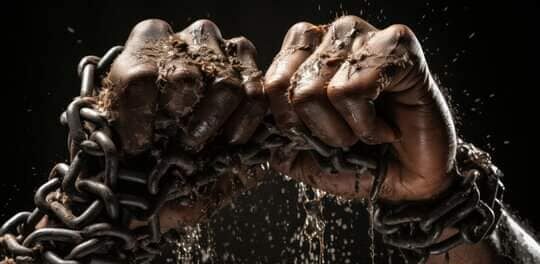EMANCIPATION ON ST. KITTS: A TUMULTUOUS AND CHAOTIC PROCESS

By Toni Frederick-Armstrong
After nearly two hundred years, the end of enslavement in the British Empire came about on the 1st of August 1834. The Act for the Abolition of Slavery (the Emancipation Act) was passed in the British Parliament in 1833, to come into effect in 1834, however each colony was expected to work out the details locally.
The British Government budgeted £20 million for compensation for former enslavers for the loss of their ‘property.’ The value of each worker was calculated based on a number of factors like age, gender and whether they were agricultural or domestic workers.
In July 1834, St. Kitts became the first colony to pass adequate legislation to support the Act that was passed in England.
The passage of the Act launched a period of Apprenticeship which lasted until 1838:
• Children under the age of six were freed immediately
• Apprentices had to work part time for their former enslavers. Generally, this meant working 40-45 hours per week without wages. If they were to work additional hours, they were to be paid.
• The apprentices were to be provided with food, clothing, shelter and medical care as under enslavement
• If an apprentice had money, he/she could pay to be released from Apprenticeship
In St. Kitts the implementation of Apprenticeship caused significant unrest and labour disturbances during the first three weeks of August 1834.
Almost as soon as word reached the island of exactly when and how this so-called Emancipation was going to come into effect, even before August 1st, many of the enslaved workers on St. Kitts started to resist, and their first tactic was basically to slow down their production.
White abolitionists on St. Kitts started advocating resistance in the hope that true emancipation might come earlier. There was some precedent because after a very close vote on the nearby island of Antigua (so close in fact, the deciding vote was cast by the Speaker of the House), all of the slaves there were to be freed immediately.
White abolitionists were not the only people encouraging the enslaved people to resist. At that time, about eleven percent of the island’s population were classified as ‘free coloured.’ Some of the most prominent of these, like Ralph Cleghorn, started to advocate for the abolition of slavery immediately, not after four or six years of apprenticeship.
In addition, the Earl of Romney and other prominent slave owners on the island, wanted to free their enslaved workers even before the law went into effect.
All of this fanned the flames of resistance among the enslaved population. As the date for emancipation drew closer, it was clear to everyone involved that the enslaved people of St. Kitts were not going to peacefully go from being enslaved to being so-called apprentices who were required to work for free.
To make things worse, the Lieutenant Governor John Nixon, suggested that even if they were freed without being apprenticed first, the former ‘slaves’ would still be compelled to work because of other clauses of the Abolition Act.
On the last day of July, when they were technically still enslaved, field workers on about a dozen of St. Kitts’s largest sugar plantations dropped their tools near the homes of the plantation managers and walked away. The ones who worked with livestock stopped their duties a couple of days later, on Saturday, August 2nd.
Not all of the plantations were involved, but on the ones that were, virtually all apprentices stopped work. It is reported that on the five or six largest plantations, like Grange and Bourryeau, there was not a single apprentice at work. Nearly eight hundred people were estimated to be protesting.
With no workforce, planters and managers were in a bind. The sugar harvest was done for the season, and it was time for the fields to be prepared for the next season, so taking care of the animals was a major priority. These were working animals, and the sugar industry was going to suffer if these beasts of burdens starved or died of thirst. Some planters resorted to letting their cattle graze on the sugarcane, but as cane is a perennial grass, doing this essentially destroyed those fields for the following season.
On August 4th, the governor announced that martial law was going to be declared if the apprentices did not return to their posts by the sixth. In the meantime, leaders of the strike were rounded up, and were publicly whipped as both a punishment and a threat to the people who had walked off the plantations. But for about the next three weeks most of the striking apprentices did not go back to work.
In the midst of the unrest, there were church services and celebrations on August 1st, to mark Emancipation. William Sendall known as Semblin, was an enslaved youth in 1834. He was still alive a hundred years later and was interviewed by a local newspaper about the first Emancipation Day. He recalled the celebration. ‘All the slaves from Cranstoun, Dieppe Bay and all over travelled to town and Massa gave them dance, plenty of food and a good time.’
Nonetheless, the upheaval on the island continued, and it took some time for order to be restored. There were no casualties reported however, sixteen of the protesters were tried for sedition and mutiny as well as inciting a rebellion. Five of them were deported to the hulk station in Bermuda. Six of them were whipped, some of them were also jailed, and the other five were apparently not punished.
Emancipation on St. Kitts was not an event but a tumultuous and chaotic process.
[Sources include the St. Kitts National Archives and the Centre for the Study of the Legacies of British Slavery]





All reactions:
15Leroy Williams Photography and 14 others
Leave a comment
You must be logged in to post a comment.